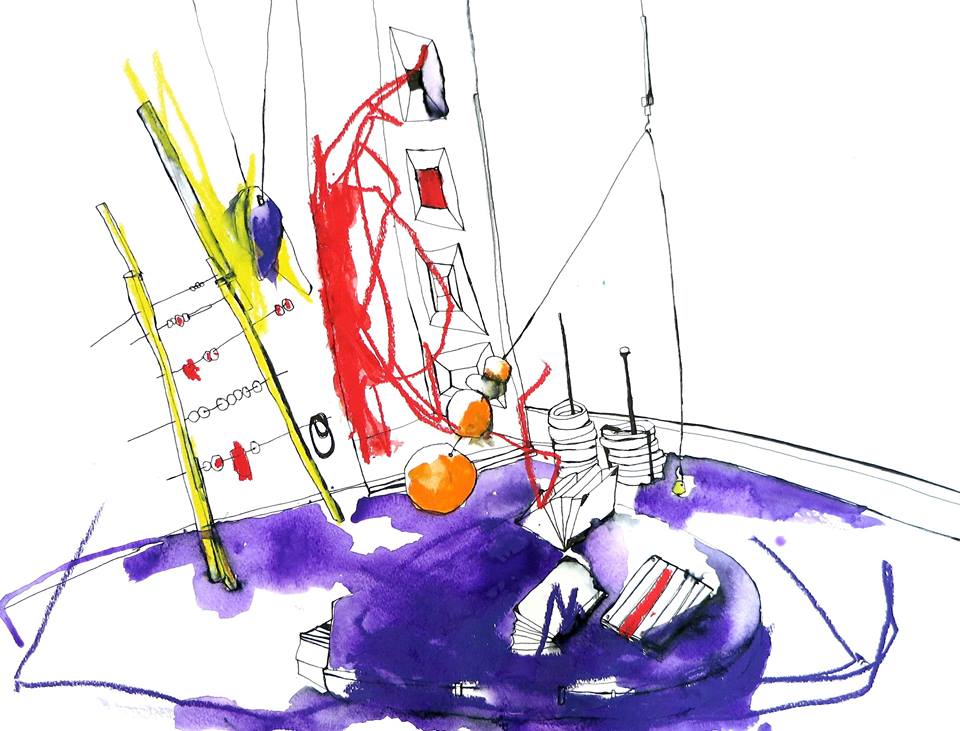
We may be going through some major transitions at Root Division with upcoming move, but that doesn’t slow us down! We are still continuing to produce high quality shows both on and offsite! For our current exhibition at the Spare Change Artist Space current RD Studio Artist Space Mie Hørlyck Mogensen has created a new body of work that explores the balance and tension between spending and saving—controlling and letting go. Pastel colored sculptural stacks of oversized round, flat plaster casts inspired by the stacking of coins, will be shown alongside video and audio actual coin stacking. Tense weights and balances explore the relationship between value and weight by bearing the weight of value. Mogensen has a history of public art installations that compel viewers to re-evaluate their surroundings. Her sculptural and video based works deal primarily with tools–both real and imagined, functional and nonsensical.
As has become the tradition, we asked the last artist to show at Spare Change Artist Space, Jennie Lennick, to interview the current artist, Mie Mogensen. Mie will also be giving an artist talk on Thursday, June 12th from 6-8 pm at the Spare Change Artist Space (465 California St., suite 838 San Francisco, CA 94104). We hope to see you there!
-Amy Cancelmo, Curator, Exhibitions & Events Coordinator, Root Division
STACK & ROLL: JENNIE LENNICK INTERVIEWS MIE MOGENSEN
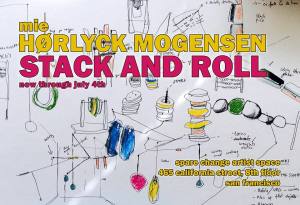
Jennie Lennick: Can you tell me a little about the new series you created specifically for Spare change?
Mie Mogensen: In Danish there is a saying that coins are round so that they can roll, and flat so that they can be stacked. For this show, I’m interested in the balance and tension between spending and saving, especially at a time when economic theories and political strategies encourage us to spend our way out of economic crisis – even those examples of crises that are themselves the result of overspending. Spending and saving also reveals an interesting binary between control and letting go – a challenge that many artists deal with in their practice.
Through various media (video, sculpture and drawing) I’m investigating elements of spending and saving in relation to the body and the physical environment that surrounds us. Inspired by the function and the shape of coins and calculating apparatuses, such as abacuses and scales, I want to question and play on the relativity, and perhaps also the absurdity, of value and its representation.
JL: What’s up with your obsession with control? You’ve told me that people often see your work as being related to or inspired by BDSM?
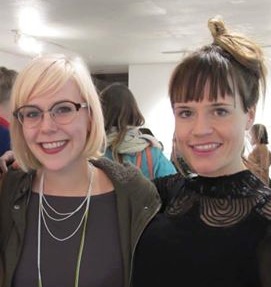
MM: Honestly, my work is not inspired by BDSM at all – but I can see why the association is evoked.
Working in materials like fake leather / vinyl, and hardware like hooks and pulleys is of course also easy to associate with BDSM, because of the material and the body like structures that seem to emerge from the construction. Also, I’m attracted to the tension between letting go and holding back, and I like creating objects that look like they are about to break out, which in turn incites the viewer to wonder what happens next.
However, I’m not at all inspired by BDSM itself, and I don’t see my work as being controlled or constrained.
Since all my work has some kind of function that is related to the body, I understand how these associations are evoked. All my work relates somehow to the body, the objects are made for our body parts to engage with them in different ways.
MM: I also like my art to have a function. It gives it its license to exist. How does function affect the form and what happens to the function when the shape changes? I’m very inspired by the relationship between function and form and I love inventing functions that you might not have seen before. In Stack and Roll I have created drawings, sculpture and video all dealing with the tension and balance of spending and saving. My sculptures are constructions made of plaster modules and hardware objects. The plaster objects are stacked like coins and held tightly together with leather bands. Or they are skewered with a stick like the beads of an abacus. Or they are placed together on a seesaw-like structure.
All the drawings have elements that you see in the show – so you can also see them as sketches for my sculptures.
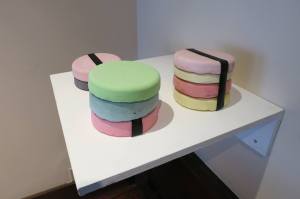
JL: What inspires you? Is your work research based?
MM: I’m inspired by my everyday and all the desires and daydreams and wishful thinking that it invokes.
Behind all my work there is hidden function, which plays a part in determining its shape and look, and my drawings are dreamlike scenarios of how I’d love my art to look were there no gravity and endless morning light.
I don’t do a lot of research – but I dream and I often think what if… or I wish… and then my imagination starts: what if I had a tool that could guide me in the right direction in life and I could just follow it – and then I go create that tool.
I’m deeply drawn in by the materials that I work with, and my art practice is very much a dialogue between me and the material. I start with an idea of how I imagine the material or medium will react. Then it turns out to be completely different from what I expected and I adjust to reality. It’s a bit like dating and being in a relationship. I fall in love with plaster, and we date and affect each other. Eventually we’ll break up and I start dating another material!
JL: Your color palette is so sickeningly sweet – it reminds me of Easter-candy colors. Can you talk a little about this choice?
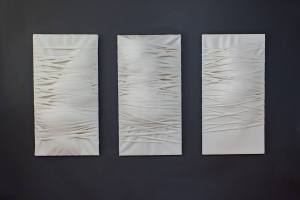
MM: Yes my palette is sweet, and I love it! And yes, it looks like Smarties!
I think my love for pastel colors comes from a childish desire for just having fun. The pastel colors are pleasing, inviting, and take you by the hand to a game where I decide the rules.
I have wondered how much I am inspired by fashion and if the colors of ‘hip’ culture affects my art. In my opinion far too few artists acknowledge how affected they are by fashion. Like fashion designers, I often work with a limited palette of colors and tend to stick to them for a long time. In my last sculpture series, I worked in the same four colors for half a year. I think my next color is red and turquoise and maybe stone spray-paint!
JL: Can you tell me a little about your choice in materials? Why vinyl and plaster?
MM: Both plaster and vinyl are material that is used for functional objects. I started working with vinyl when I worked with ceramics, and I combined the two in various ways. Vinyl has a shiny surface like the glaze of ceramics, its softness has an interesting tension with the hard and heavy ceramics.
The vinyl is not a gentle fabric. When you work in soft sculpture it too easily becomes sweet or nostalgic, but the harsh vinyl won’t let you.
Plaster is just so much fun to work with and it hardens so fast! It’s so satisfying for me to work with. I work very fast and I enjoy the immediate output of working with plaster. Plaster is fragile in another way than ceramics and it has a lighter and more refreshing feel than the ceramics. To me, plaster is a gentle and playful material to work with. Also, I like the combination of hardware units together with the plaster. To me, the hardware units are heavy, rough and determined to a function that sort of ‘grounds’ the ‘spherical’ plaster objects.
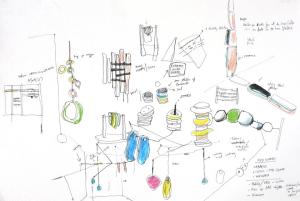
JL: To me, your work seems to be all about duality- sweet but gross, valuable but worthless. How does this concept relate to your weight and balance pieces?
MM: Yes, my work is definitely about duality! I work in a constant dialogue of yes and no – attraction and repulsion. I guess I like the confusion or vibration that come out of that duality. If I’m just pleased by making a piece then my relationship with that material is over right away. My hope is that the viewer of my work somehow feels some of that same conflict.
JL: You used so many different media in your exhibition, like video, drawing, and sculpture. How do you decide what media to use?
MM: Yes, in this show I’ve used a lot of different media. I enjoy dealing with a lot of different media at the same time. It’s a process that challenges me and pushes me to keep my senses open and constantly question the medium I’m using. Finally, I think it’s a great way to explore a topic in order to address a story from different angles.
I’m not sure which media I want to use from the beginning. It works more like a laboratory where I try out various media and materials. Often I have a vision of how a piece should work, but when I make it it turns out to work completely different from what I expected. Video can do something that drawing can’t, and it’s the same with sculpture, performance, etcetera.
JL: Do you believe that presenting your work in a financial planning office changes the way your work is viewed? How do you see it being read in this context?
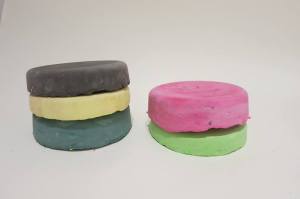
MM: Yes! It was a big challenge to install in this kind of space but I’ve learned a lot from it! To integrate abstract figures and drawings in a functional space is a very tricky thing to do. I think it’s a question of letting both worlds co-exist without letting one dominate the other. A financial office is loaded in a way that I’m not familiar with at all, and visitors of the space are primary interested in getting counseling rather than looking at art.
I imagine how clients would let their eyes wander on the work as they listen to the advice they get – I’m not sure if they see it as art. I think they rest their eyes while being counseled. Hopefully some of the work makes an impression in their memory afterwards.
Working with public art in Europe, it was my goal to bring out art into the public space and break out of that ‘white cube’ where only people who would be a part of the art world would go and meet other art people! I wanted expand the perception on art as vernacular and something easily integrated in our everyday lives, and Stack and Roll speaks to this notion. At the moment I’m also showing my art in a hotel lobby and I have worked in material that relates to that environment (miemogensen.com/leanonme).
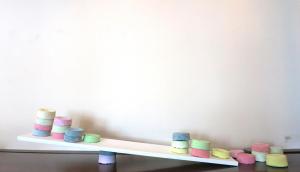
JL: What are you working on next? Any new and exciting projects?
MM: At the moment I have three shows coming up in San Francisco and if you have the time and feel like it, you should check out the other two shows I that are coming up:
The first one is called Everyday Zeal and is installed at Alter Space (1158 Howard Street) until July 15th. I worked site specifically with plaster, ceramic and hardware components, and experimented with unorthodox ways of installing sculpture in a gallery space. I will be doing a performance with dancer and performance artist Renee Rhodes on Friday June 13th, 7 – 8pm, where visitors can join us in a collective nap!
Also, if you happen to be downtown before September 1st, I have sculptures installed at the Refusalon Gallery (Marriott Hotel, 500 Post Street). For this space, I created pieces that are a mixture of furniture and pedestal, 2D and 3D. I want people to interact with them and encourage them to sit and lean on them!
You can check out both shows at my website miemogensen.com.
Also coming up is a two-month trip to my native Denmark. While traveling, I will focus on drawings and sketches for my next project that will probably include some wood. I’m very fascinated by old leftover wood at the moment and I would love to create site-specific installations and mobiles out of wood. I’m also planning collaborations with other artists that inspire me.
Last but not least, I’m working on a children’s book with drawing and text that I have been working on for a while.
